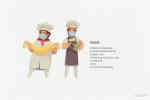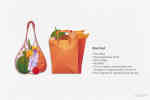Step 1 of 5•8 minutes read
Micro-Biological Contamination and Control
Below are your keywords for this section of your training. These words you will use during your work and will appear in the final exam so be sure you learn them.

(Remember: Microbiological contamination results in food poisoning)
Remember from the last section that Microbiological contamination results in food poisoning. Microbiological contaminants need to come from somewhere, known as the source. A source may be considered as the origin of the food poisoning bacteria, for example, the chicken on the farm that laid the contaminated egg, or the 'thing' that brought bacteria into the food business, e.g. the egg.
People are the biggest sources of bacteria in the food environment. These can be chefs, stewardesses, other crew, suppliers, passengers and visitors to the ship. Contamination by people can happen at all stages of the storage, preparation, cooking and serving process.
There are a number of ways microbiological contamination can happen from people. The video below explains the main controls. On board, however, there are extra controls that you may be familiar with and these are:
Hand washing for passengers and crew. Some larger vessels have specific hand wash sinks for entering food dining areas both for passengers and crew. Otherwise, plenty of anti-bacterial hand gel dispensers with clear signage must be used. A good practice is a crew member welcoming passengers into the dining areas to ask them to use the anti-bacterial hand gel.
Sneeze Guards: Buffets can have clear glass guards over the food on display to prevent contamination from coughing and sneezing. In particular, help yourself buffets.
Served Buffets: Most ships now operate a served buffet by chefs with the food protected from passenger contamination by glass screens. The chefs will serve the food to passengers and hand them the plate. This also stops passengers from contaminating any service utensils with dirty hands if they help themselves to food. Chefs will be wearing full uniforms, with disposable gloves and face masks.
Note: It may still be company policy for all crew and/or passengers to wear disposable masks in line with COVID-19 infection prevention.

Raw food to be cooked and raw food ready to eat are all sources of bacteria.
Bacteria from both raw food to be cooked and raw food ready to eat can contaminate high-risk foods. Always store raw food in sealed or covered containers. It is best practice to wash fruits and vegetables before storing them to prevent contamination.
TOP TIP: Soil and dust which is full of bacteria are very often in the bags and packaging for raw food to be cooked. Think about washing before transferring to pantry fridges around the ship.

Bacterial Contamination from Animals
All sorts of pests can contaminate food before delivery if it is not covered and stored correctly. Removing as much packaging as possible on the dock and not bringing boxes on board is a good way to prevent insects and animals from boarding. Checking for insects and washing fruits and vegetables are very important.
TOP TIP: You will experience many different types of insects on your travels around the world. It's important to be vigilant when shopping at local markets.

Bacterial Contamination & Waste
On board, under MARPOL (Maritime regulations for preventing pollution at sea) waste disposal is highly regulated and ships are required to keep a waste log. Stipulating what waste is created and where it was disposed of, for example in regulated waste disposal in port.
Food waste that can build up and attract pests, and animals and support bacterial growth must be taken off the board as soon as possible in port and disposed of in the correct way. When at sea, throwing food waste over the side is also strictly regulated. Below is a guide to help you but on large ships, there are crew members that will handle all waste from food to recycling in line with MARPOL.

MARPOL Guidelines:
Your captain and safety officers will be aware of which area you are sailing and if they are special areas. Below is an extract only from MARPOL that is related to food safety. You do not need to understand all the regulations for your exam but it's good for you to know a part of your job role.
NOTE: There are special sailing areas that your captain and safety officer will communicate.
Food waste that is comminuted or ground:
- Outside special areas: discharge is permitted at a distance of greater than 3 nautical miles from the nearest land and en route (underway) as far as practicable.
- Within special areas: discharge is permitted at a distance greater than 12 nautical miles from the nearest land and en route (underway) as far as practicable.
Food waste that is NOT comminuted or ground:
- Outside special areas: Discharge is permitted at a distance of greater than 12 nautical miles from the nearest land and en route (underway) as far as practicable.
- Within special areas: Discharge prohibited.
If storing food waste for a period of time, store using a leakproof container or bag, sealed to avoid attracting pests. Have a designated area for food waste. Wash food waste packaging and containers that are to be disposed of to reduce bacterial growth and smells.
Some larger ships and cruise liners have designated cold storage for food waste to prevent the multiplication of bacteria.
Before watching the video remind yourself that:
- "Route": The path taken by bacteria from sources to ready-to-eat foods.
- "Vehicle": In cross-contamination, the vehicle is how bacteria transfer from source to ready to eat food e.g work surface, cloth, hands, equipment etc.
Take the time to watch these 2 videos below.